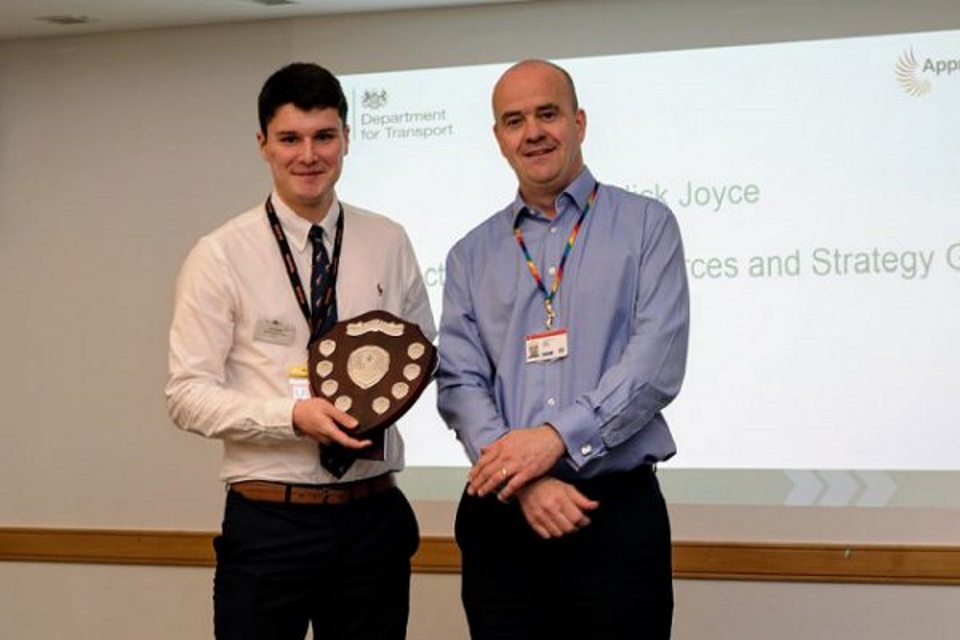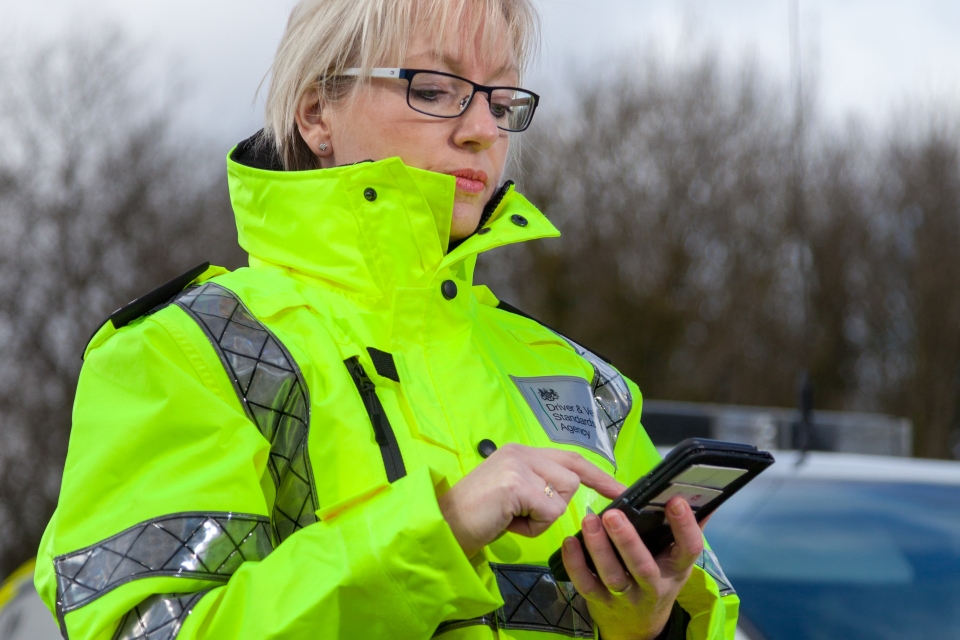DVSA strategy: annual progress report, 2017 to 2018
Published 19 July 2018
Introduction
These are the achievements from the first year of the Driver and Vehicle Standards Agency (DVSA) strategy for 2017 to 2022. They’re arranged by the themes in the strategy.
We’ve also developed supporting strategies for the areas that are essential for the strategy to be successful. These will give us the people, infrastructure and relationships that we need need to help you stay safe on Great Britain’s roads.
The DVSA annual report and accounts for 2017 to 2018 has more details on both strategic and operational performance. The DVSA annual review for 2017 to 2018 tells the stories behind some of the achievements in the year.
Helping you through a lifetime of safe driving
What we do
We make sure new drivers are better prepared for a lifetime of safe driving and have access to guidance, advice and training that helps to keep them safe.
We now also do more to make sure driving tests are available at times and places which are more convenient for learner drivers.
We improved the driving test

Changes to the driving test, including following directions from a sat nav, were introduced on 4 December 2017.
On 4 December 2017 after strong support in public consultation we improved the car driving test by including following directions from a sat nav and testing different manoeuvres. We did this because:
- most fatal collisions happen on high-speed roads (not including motorways) - changing the format of the test allows more of these roads to be included in driving test routes
- most car drivers have a sat nav and new drivers will now be trained to use them safely
- research showed that new drivers value training in independent driving - they can relate it to driving once they’ve passed their test
Better information about training
We improved the information on the find driving schools, lessons and instructors service on GOV.UK.
Now people can make more informed choices. The service holds details of 26,000 approved driving instructors (ADIs) and is helping around 10,000 people a week.
26,000 approved driving instructors showing their details on GOV.UK
Modern instructor training and assessment
To make sure new drivers get the best possible training, we improved how we assess whether new driving instructors have the knowledge, modern driving skills and understanding they need.
Training external assessors
Our programme to train external assessors to carry out Driver Certificate of Professional Competence part 4 tests themselves brought the total to over 200.
As well as increasing capacity, this adds flexibility and reduces the time taken for safe bus, coach and lorry drivers to get qualified, find work and start serving British industry.
Allowing learners on motorways
We publicised the change to the law that allowed learner drivers to drive dual-control cars on motorways with a DVSA-approved driving instructor from 4 June 2018.
This helped the public to understand the thinking behind the change in the law and that the decision was based on strong support in a public consultation.
We also supported ADIs’ representative groups who developed guidance for their members to plan, manage and get the most benefit for learners out of such lessons with minimal risk.
From this, we were able to update theory test questions, ADIs’ and learners’ resources and The Highway Code.
Joining up cycling standards and driving and riding standards
We worked with the Bikeability Trust to review National Cycle Training. This created a new Rider Standard and a Cycle Instructor Standard.
This new consistency in the skills and understanding taught to young cyclists and future motorists will help people stay safe on the roads for generations.
What we’ll do next
To continue helping you through a lifetime of safe driving, we will:
- work with the Department for Transport (DfT) on research to evaluate interventions for young and novice drivers, for example, by exploring the potential benefits of voluntary digital log books to help ADIs and learners to plan and record lessons
- continue to help ADIs to prepare their pupils for theory and practical driving tests, for example, by promoting the benefits of instructors accompanying their candidates on their tests
- build on our work with the Bikeability Task Force
- increase the take up of post-test motorcycle training, for example, by relaunching the DVSA enhanced rider scheme
- review the emphasis in our education, information and guidance on more fuel-efficient driving
- develop our understanding of how emerging vehicle technologies will impact on our services through our links with the Centre for Connected Autonomous Vehicles and to the Law Commission’s review of Road Traffic Law
- explore how we can use technology to replace the paper-based administration of driving tests - this will make it quicker to issue driving licences, reduce the potential for fraud, and improve the accuracy of our data so we can target and improve trainer standards
Helping you keep your vehicle safe to drive
What we do
We make sure you know where and when you can get your vehicle tested so you know it’s safe to drive, and what checks you should do all-year-round.
MOT and vehicle recall services
On GOV.UK, we:
- launched the MOT reminder service which provides free reminders by email or text message - 660,000 users had signed up by 31 March 2018
- improved the MOT history service by adding test results for lorries, buses and coaches, and adding information about outstanding vehicle recalls affecting the vehicle
- improved information to garages contributing towards improved test quality
660,000 users had signed up for MOT reminders by 31 March 2018

The service to get MOT reminders launched in beta in November 2017.
Working with DfT we also improved the annual test itself so we can better measure emissions at MOT across all vehicle types.
We developed the MOT training model to contribute toward improved standards of MOT standards.
We also improved vehicle recall services and information to help people stay safe.
Our vehicle tests were updated throughout to reflect EU directive changes, for example, we modified and improved the manuals setting out our testing and enforcement standards.
What we’ll do next
To continue helping you keep your vehicle safe to drive, we will:
- keep improving the MOT services that we provide directly to the public, including the test documentation.
- build on work hard to make sure that more people get their MOTs on time, in particular through encouraging take up of our reminder service
- support MOT garages with better processes to approve new garages and process changes to existing ones
- improve our systems to help testers record results correctly as part of the changes under the EU Roadworthiness Directive
- start to transform commercial vehicle testing, for example, engaging with the industry and staff to research user needs
- explore options for improving the availability and quality of information, for example by:
- adding heavy vehicle test histories online
- information by manufacturer
- motorist guidance
- providing more data to MOT garages
- increase emphasis on how to look after your vehicle in our education, information and guidance
- work with partners to develop proposals for change relating to new vehicle technology, including connected and autonomous vehicles
Protecting you from unsafe drivers and vehicles
What we do
We stop dangerous and high-risk operators and drivers from using Great Britain’s roads and make sure that it’s financially better to follow the rules than break them.
We work with vehicle manufacturers to reduce the number of safety defects in vehicles and make sure that any defects are always found and fixed quickly.
Emissions control
We carried out a pilot to target enforcement on emissions control manipulation.
MOT fraud
We implemented plans for better identification, investigation of and actions against anyone found to be committing fraud.
Drivers’ hours
We gave our enforcement examiners the ability to record and process drivers’ hours offences for historical offences as well as current ones.
DVSA earned recognition

After a successful year-long pilot, DVSA earned recognition was officially launched at the Commercial Vehicle Show in April 2018.
We developed the DVSA earned recognition scheme. This allows commercial vehicle operators to share their data and procedures with us, to give us enough confidence in them that we can divert enforcement operations towards other operators who are providing us with less assurance. We promoted this so successfully that over 60 operators signed up.
What we’ll do next
To continue protecting you from unsafe drivers and vehicles, we will:
- fully roll out the DVSA earned recognition scheme
- improve our ability to identify and target high-risk operators
- continue to develop our capability to rate garages by risk
- explore how digital services might help us to counter fraud better, for example, by connecting directly to vehicles and test equipment
- plan to target emissions control manipulation
- improve the recall process to make reporting of safety issues by consumers and manufacturers easier and more effective
- find ways to identify potential recalls earlier
- find ways to prioritise safety defects by risk, and work with the manufacturers to introduce timescales to fix them
- work to introduce a road haulage permit system to give the UK contingency plans for hauliers to continue to access the EU upon exit
What the strategy depends on
At DVSA, there are 3 areas which are essential for our strategy to be successful:
- our people
- our infrastructure - including digital, data and technology infrastructure, and estates
- our relationships - including commercial relationships, and how we at DVSA communicate and work with others
A great place to work
We launched pilots of a management development programme and a senior leadership programme and introduced management and leadership apprenticeships.
There are over 80 apprentices as driving examiners and vehicle standards assessors, as well as in our contact centres and our digital and corporate teams.
80+ apprentices working at DVSA
One of our members of staff was awarded DfT Apprentice of the Year.

Tom Parkin was named Department for Transport apprentice of the year.
We improved the way we recruit driving examiners and vehicle standards assessors, for example, by using social media to extend the reach of our advertising, with job profile film clips and new selection methods promoting inclusion.
We promoted our values of equality, diversity and inclusion with a particular focus on acceptable behaviour. Our ‘building respect’ workshops will reach all 4,700 staff. We’re working on plans for further training with our staff network groups:
- embRACE - representing black and minority ethnic colleagues
- Enabled - representing colleagues with a disability
- Pride - representing lesbian, gay, bisexual and transgender colleagues
- Time2Care - representing carers
- Women’s Integrated Network - representing women
We supported our people’s wellbeing with flu jabs, a physio scheme and a comprehensive new employee assistance programme offering free financial, career and health advice.
Over 3,000 staff responded to the 2017 Civil Service Survey People Survey and:
- the overall engagement index rose by 6 percentage points to 49%
- all directorates increased in engagement index
- results for 8 out of the 9 themes in the survey improved
A sustainable estate
Over 75% of the motorcycle fleet was replaced for staff carrying out motorcycle rider tests.

Over 75% of the motorcycle fleet was replaced.
All new cars and motorbikes are now leased on a 3-year rolling contract so they are replaced and refreshed regularly, keep up with the latest technology and keep the fleet efficient and sustainable.
We continued modernising our estate, supporting modern service delivery, and modern, flexible working environments.
We continue to work to ensure that our administrative estate is the right size and is ideally located.
A digitally-enabled organisation
We equipped frontline enforcement staff with smartphones and apps that have been developed in-house, so we can, for example, let staff see the status of vehicles on the road more accurately and quickly.

DVSA traffic examiners can now access vehicle and operator details more easily through a smartphone app.
These make real-time, information on vehicle operator licence details available at the roadside, using an app to analyse digital tachograph records, and a new online payments facility to collect penalties efficiently at the roadside.
We gave tablets to driving examiners, giving them instant access to our systems. Ultimately this will let us digitise driving tests and replace paper-based processing.
We started researching alternative ways to deliver theory tests using emerging technologies to offer greater flexibility in assessing learner drivers.
We started giving MOT testers information in new ways through GOV.UK to help them make the right decisions.
Creating outstanding value
We led on implementing a new total facilities management contract for both DVSA and the wider Department for Transport.
We started up an in-house IT user centre, that will save almost £200,000 over the next 10 years.

We brought our IT service desk in-house to provide a better service and save almost £200,000 over the next 10 years.
We moved to a single new system for human resources, finance, procurement and payroll, with centralised standard support.
We continued to improve ways to make sure the way we buy goods and services is sustainable.
Trusted communication, effective relationships
Our highly successful campaign to inform the public, learners and driving instructors about changes to the driving test won the Chartered Institute of Public Relations’ (CIPR) Excellence Award for the best public sector campaign.

Abigail Britten and Olivia Roe collected the CIPR award on behalf of DVSA.
Our news story about the changes to the driving test was the most-read news story on GOV.UK in 2017.
We started a new service to offer people reminders before their MOT is due and improved the information available about vehicle safety recalls.
We reviewed the guidance for driving instructors on what qualifies as a fit and proper person to become an ADI.
We revised the official resources for learners and trainees and the theory tests for drivers of all vehicles to improve accessibility, especially for people on the autistic spectrum or with learning or literacy difficulties.
Once again, we stressed the importance of safety checks for people towing trailers under the hashtag #TowSafe4Freddie and publicised the National Trailer and Towing Association’s offer of free safety checks for trailers in memory of Freddie Hussey.
What we’ll do next
To continue making sure our people, infrastructure and relationships support our strategy, we will:
- digitise the annual test for heavy goods vehicles, buses and coaches, developing new cloud-hosted systems for our testing, recording and payment transformation services
- improve the way people get information about vehicle safety recalls
- develop a sustainability strategy
- get closer to our customers and partners, reviewing how we engage so that we always put the user first and promote positive behaviour change in all our dealings and communication
- launch 3 priority communications campaigns to:
- encourage learner drivers to make sure they’re ready for their driving test when they take it
- get more people to sign up for MOT reminders - particularly for those using a family vehicle
- reduce the number of lorry, bus and coach drivers breaking drivers’ hours rules and driving tired
- make our correspondence and general communications plainer, simpler, more effective and accessible
- support the public and driving instructor industries with information and publicity about the new law to allow learners drive dual control cars on motorways with an ADI
- update The Highway Code to reflect new laws on using remote control to park cars
- let and initiate a new contract to become DVSA’s and The Highway Code’s official publisher
